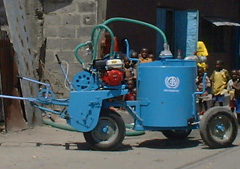Income generation through the provision of integrated sanitation systems for low-income urban communities.
Bringing relief to slums – a novel way to remove human waste safely and economically
The challenge
 A lack of basic services is characteristic of low income settlements where the urban poor pay high prices for the little water and sanitation provision they receive. World leaders, major donor agencies, public and private organizations and the general public at large have committed themselves to redressing this situation under the Millennium Development Goals by targeting to halve those without access to adequate water and sanitation by the year 2015.
A lack of basic services is characteristic of low income settlements where the urban poor pay high prices for the little water and sanitation provision they receive. World leaders, major donor agencies, public and private organizations and the general public at large have committed themselves to redressing this situation under the Millennium Development Goals by targeting to halve those without access to adequate water and sanitation by the year 2015.
The problem of water and sanitation in cities is attributable both to the growth of the city populations, and to escalating poverty itself. According to the 2001 Global Report on Human settlements , over 1 billion people live without adequate shelter and access to basic services. An estimated 300 million people lack access to adequate sanitation. Their numbers come to double those without water supplies. The economic impact this has in terms of health and socio-economic capacity of individuals is huge.
Investing in sanitation infrastructure will go a long way to achieving these goals. But it has to go hand-in-hand with adequate human waste removal.
Background
On-site human waste disposal still remains the only option for the millions of poor living in informal settlements and unplanned areas. The conventional waterborne sewerage is hampered by a multitude of limitations in these areas and consequently simple and ventilated improved pit (VIP) latrines remain the common choice of sanitation facility. In these settlements, when the latrines become full the closing down and relocation of these latrines is often not possible because of the limitation of space and so they have to be emptied. Emptying of pit latrines is done either manually or mechanically.
After studying the situation in slums around the world, UN-HABITAT sought to devise a system that would replace manual emptying. It commissioned a mechanical system that would be capable of being manufactured locally using readily available components, that would be affordable, easily serviceable, able to operate in narrow passageways where other conventional exhauster vehicles cannot pass, and capable of sucking out dense waste sludge for transportation to a larger tanker vehicle. At the same time it was imperative that excrement be removed as safely as possible without posing further health hazards in slums.
Thus in 1995 Manus Coffey and Associates Ltd (MCA) and UN-HABITAT designed and built the first prototype in Ireland: the MK I UN-HABITAT Vacutug.